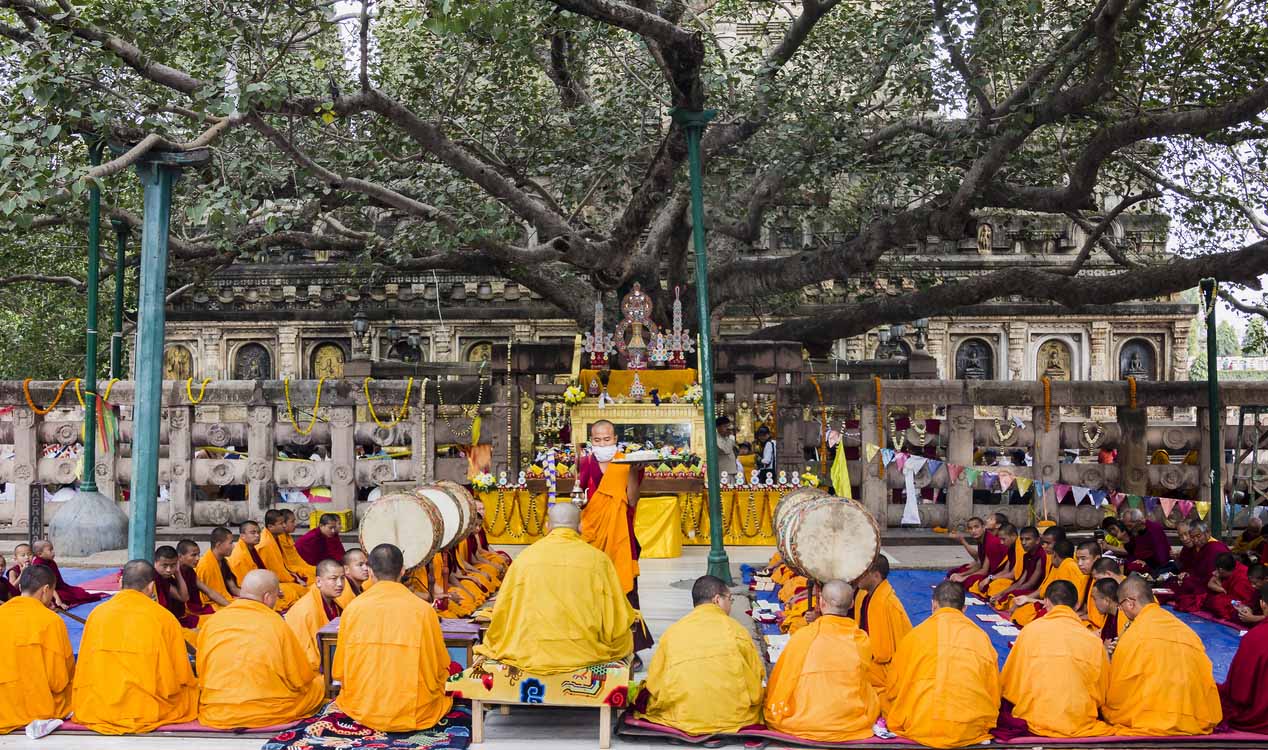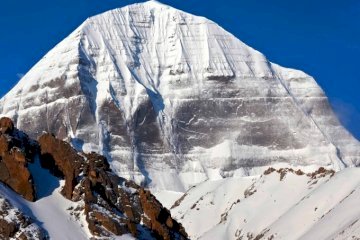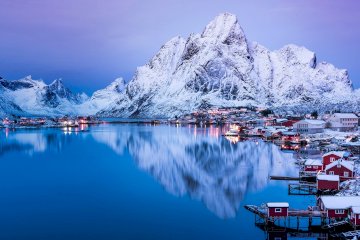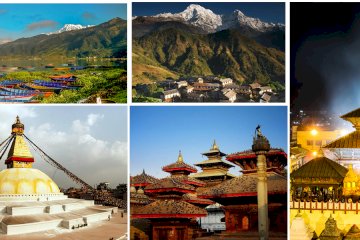Overview
Discovering Buddha’s Footprints – a journey to Shavasti, Lumbini, Kushinagar, Rajgir, Bodhgaya, Sarnath and Varanasi is a spiritual journey that takes you through some of the most important Buddhist pilgrimage sites in India and Nepal. The 11 days tour is designed to provide a complete and immersive experience of the life and teaching of Lord Buddha. Starting from Delhi, the tour takes you to the ancient city of Shravasti, where the Lord Buddha spent 24 rain seasons and delivered some of his most famous discourse. From there, you will visit Lumbini, the birthplace of Lord Buddha, which is situated in present-day Nepal. This holy site in home to several monasteries, temples, and stupas, including the well-known Maya Devi Temple, which is built around the spot where Lord Buddha was born. Your next destination is Kushinagar, the place where Lord Buddha passed away and attained Parinirvana. Here, you will visit the Mahaparinirvana Temple, which houses a magnificent reclining Buddha state as well as several other important sites related to Lord Buddha’s final days. This tour also includes a visit to Rajgir, a scenic town nestled in the foothills of the Himalayas. This was the site of the First Buddhist Council and is home to several important Buddhist sites, including the Vulture’s Peak where Lord Buddha delivered some of his most important sermons. Other highlights of the tour include Bodhgaya, where Lord Buddha attained enlightenment under the Bodhi tree and Saranath where he delivered his first sermon after attaining enlightenment. The tour ends in Varanasi, one of the oldest and most sacred cities in India where you can witness the Aarti ceremony on the banks of the Ganga River and explore the city’s many temples and holy sites. Overall, discovering Buddha’s Footprints in an unforgettable journey that offers a deep insight into the life and teaching of Lord Buddha, while also providing a glimpse into the rich cultural heritage of India and Nepal.
A Journey to Shravasti, Lumbini, Kushinagar, Rajgir, Bodhgaya, Sarnath, and Varanasi :8 Days & 7 Nights : Minimum Group Size – 4 Pax
Day-wise Trip Itinerary
Day – 1 : Arrival at Gaya : Upon arrival at the Gaya International airport, you will be met by SkyRoute Travel representative who will transfer you to the pre-booked Hotel. You can then relax and enjoy some leisure time before settling in for an overnight stay. If time permit, evening head-out to explore Bodhgaya.
Day -2 : Bodhgaya Tour : After breakfast, get ready for a full day city tour of Bodhgaya, visiting various sacred and historical sites in the area :
(1) Mahabodhi Temple – It is a UNESCO World Heritage site and believed to the exact spot where the Buddha achieved enlightenment while meditating under a Bodhi tree over 2,500 years ago. The Mahabodhi temple is a magnificent structure that stands at a height of 55 meters and adorned with intricate cravings and statues. The temple complex comprises the main temple, meditation park, Bodhi tree, and numerous shrines and stupas. The Mahabodhi temple is a place of great spiritual significance and attracts millions of pilgrims and tourists from all over the world who come to pay homage to the Buddha and seek inner peace and enlightenment (2) Bodhi Tree – It is a sacred fig tree and believed to be the sport where the Buddha attained enlightenment over 2,500 years ago. The current three is a descendant of the original tree and is highly revered by Buddhists around the world as a symbol of the Buddha’s spiritual journey (3) Bodhgaya Archaeological Museum – (4) Royal Bhutan Monastery (5) Great Buddha Statue – The Great Buddha Statue is a prominent landmark located in Bodh Gaya, India. It is one of the tallest statues of the Buddha in the world and stands at a height of 80 feet. The statue is made of sandstone and was built in the 1980s by the Dalai Lama and the government of Bihar. The Great Buddha Statue is a popular destination for tourists and pilgrims alike, who come to marvel at the impressive structure and pay their respects to the Buddha. The statue is surrounded by serene gardens and offers a peaceful and tranquil atmosphere for visitors to meditate and reflect. (6) Japanese Temple (7) Thailand Monastery (8) Sujata House – a temple situated near the Falgu River in Bodhgaya, dedicated to an Uruvela tribeswoman named Sujata. According to the legend, Siddhartha Gautama (The Buddha) had been fasting and practicing asceticism for six years when Sujata offered him a bowl of rice pudding, which gave him the strength to continue his journey towards enlightenment. The site is now a popular destination for Buddhist pilgrims who come to offer prayers and offering in honor of Sujata’s generosity. The temple features beautiful architecture and is surrounded by lush greenery, making it a serene and peaceful place to visit. Niranjana and Dungagiri Caves : The Niranjana Cave is believed to be the place where the Buddha meditated and attained enlightenment and the Dungagiri cave is located on a hill and believed that where Buddha spent several rainy seasons in meditation. Both caves are important pilgrimage sites for Buddhists and offer a unique insight into the life and teachings of the Buddha. The natural beauty and peaceful atmosphere of the surrounding area make these caves a must-visit destination for anyone travelling to Bodhgaya. Evening return to the Hotel and overnight stay in Buddhgaya.
Day 3 : Buddhgaya-Rajgir (75 kms – 2 hours travel): Today after breakfast, depart from Bodhgaya and head to Nalanda, where you can visit the ancient Nalanda University – The Nalanda University was one of the oldest and most famous centres for higher learning in ancient India. Situated in the present-day Bihar, it succeeded from 5th to 12th Century CE and attracted researchers from across Asia. The university offered courses in various subjects such as philosophy, astronomy, mathematics and medicine and had an wide-ranging library with over 9 million books. Today, the ruins of the university are a UNESCO World Heritage site and a major tourist attraction in Bihar (India) and the Nalanda Archaeological Museum. Further, drive to Rajgir and visit (1) Vulture’s Peak -where the Buddha gave some of his most famous teachings (2) Rajgir’s hot springs (3) Shanti Stupa (4) Gridhakuta Peak – a sacred Buddhist site located at the top of Ratnagiri hill and believed that Buddha gave may of his important teachings including the Lotus and Heart Sutra. The peak offers breathtaking panoramic views of the surrounding hills and valleys. (5) Peace Pagoda – a beautiful Buddhist structure built by the Japanese Buddhist monk, Nichidatsu Fujii, in 1969. It is one of the 80 Peace Pagaodas built around the wold to promote peace and non-violence. The Pagoda is adorned with beautiful statues and offers stunning panoramic views of the surroundings hills. (6) Rajgir Fort – it is known as the Girivrajapura and believed to have been the capital of the Magadha empire and was later used as a military base by Maurya and Gupta empires. Visitor can explore the ruins of ancient structures such as the Jain temple and the Maniar math. (7) Pippala Cave – it is an important Buddhist site located at the foothills of Vaibhara Hill. It is also believed to be the place where the Buddha meditated and gave teachings to his disciples. The cave is a peaceful and serene place to visit with natural springs and beautiful rock formations surrounding it. Visitors can also explore the nearby hot springs, which are believed to have medicinal properties. If time permits, make a visit to Venuvanaram and Bimbisara Prions, Rajgir – Venuvanaram is a monastery where the Buddha is belived to have stayed and given teachings while Bimbisara Prison is the site where the King Bimbisara was imprisoned by his son Ajatashatru. Both sites are significant for their historical and religious importance. Evening return to the Hotel Rajgir and overnight stay.
Day – 4 : Rajgir – Varanasi (250 kms – 6 hours): After breakfast, leave for Varanasi. After arriving at Varanasi, check into the hotel. Once you have settled into the room, take an advantage of the leisure activities available to you at your own pace. Overnight stay at Varanasi
Day 5 : Full day Visit to Saranath : It is an significant Buddhist pilgrimage site situated near the city of Varanasi. It considered one of the four most important pilgrimage sites in Buddhism, along with the Bodhgaya, Lumbini and Kushinagar. Saranath is the site where the Buddha gave his first address after attaining enlightenment, and it holds immense spiritual and historical significance for Buddhists around the world. Today Saranath is home to numerous important Buddhist landmarks, including ancient ruins, temples, and monasteries. The most famous landmark in Saranath is (1) the Dhamek Stupa – a massive and impressive structure that is said to be built at the site where Buddha gave his first address. The stupa is one of the largest and most well-preserved stupas in India, and it is an important place of pilgrimage for Buddhists. Other important landmarks in Saranath include the (2) Chaukhandi Stupa – it is believed to mark the spot where Buddha met his first disciples and (3) the Mulagandha Kuti Vihar – a temple that is believed to be the site where Buddha spent his first rain season after attaining enlightenment. (4) The Saaranath Archaeological Museum is also worth a visit – as it houses a collection of Buddhist artifacts, including ancient sculptures, inscriptions, and relics. Overall, a visit to Saranath is a must for any Buddhist pilgrim visiting India as it provides an opportunity to connect with the roots of Buddhism and experience the spiritual and cultural heritage of this ancient religion. The peaceful and serene environment of Saranth, combined with its rich history and cultural significance, make it a truly unforgettable destination for any Buddhist Tour.
Day 5 : Varanasi to Kushinagar (250 kms – 6 hours travel) : Before departure to Kushinagar, enjoy a morning boat ride on the holy river Ganga – An early morning boat ride in the Holy River Ganga in Varanasi is a magical experience that allows you to witness the city come to life as the sun rises. As you glide along the river, you will see the people performing their morning prayers and rituals and witness the stunning beauty of the city’s many ghats and temples. It is a serene and unforgettable experience that captures the essence of Varanasi. After boat ride return to Hotel for breakfast and subsequently check out the Hotel and proceed to Kushinagar. Afternoon, reach Kushinagar and check into the Hotel. Evening get ready to visit Kushinagar :. It is believed to be site where the Buddha attained Maha Parinirvana or final enlightenment and passed away. As such, it is an important destination for Buddhist spiritual tours, and attract pilgrims from around the world. The main attraction in Kushinagar is the (1) Mahaparinirvana Stupta which marks the spot where the Buddha is believed to have passed away. The stupa is a massive and impressive structure that is decorated with beautiful carvings and statues of the Buddha. Other important landmarks in Kushinagar include the (2) Ramabhar Stupa – it is said to mark the spot where the Buddha was cremated and the (3) Mathakaut Temple – it is houses a beautiful statue of the Buddha. A visit to Kushinagar is a powerful and moving experience that allows pilgrims to connect with the spiritual roots of Buddhism and pay respect to the Buddha’s life and teachings. The tranquil and peaceful environment of the site, combined with its rich historical and cultural significance, make it a truly memorable destination for any Buddhist spiritual tour. After visiting above places, return to Hotel and overnight stay.
Day 6 : Kushinagar – Lumbini (Nepal) (140 kms – 3 hours travel) : About Lumbini – It is situated in the Southwestern Terai region of Nepal and one of the world’s most sacred sites. This site is a UNESCO World Heritage Site that attracts millions of pilgrims. Lumbini is known as a birthplace of the Buddha and it is said that it was here that Prince Siddhartha Gautama was born in 563 BCE. The city is home to many important historical and religious landmarks including (1) the Maya Devi Temple where the Buddha was born. (2) Ashoka Pillar which marks the spot where Emperor Ashoka erected a pillar to commemorate his pilgrimage to the site in the 3rd century BCE. In addition to these significant landmarks there are several things to do in Lumbini that offer visitors chance to connect with the spiritual and cultural heritage of the city (3) One of the top activities is to take a stroll in the beautiful Lumbini Garden which was designed by a Japanese architect to represent the Buddhist philosophy of the Four Noble Truths and the Eightfold Path. The garden features a peaceful and serene atmosphere that is perfect for meditation and reflection. You can also explore the various monasteries temples and stupas that have been built by different countries including Sri Lanka, Thailand, Myanmar and China among other. Overall, Lumbini is a attractive destination that offers a unique blend of history, spirituality and culture.
Day 7: Lumbini – Sravasti (179 kms and travel time is around 4 hours by crossing international . The Common route is travelling Lumbini to the Indian border town of Sunauli and continuing through Gorakhpur and on to Sravasti) : After breakfast, check out the Hotel and get ready to move to Sravasti.
Sravasti – it is an ancient city situated in Uttar Pradesh (India) known for its rich cultural and religious heritage. According to Buddhist tradition, the Buddha spent 24 rainy seasons, preaching and performing miracles for his followers. Now a days, the city is home to number of important Buddhist pilgrimage sites, including (1) The Jetavana Monastery – it is an important Buddhist pilgrimage site build by the wealthy merchant Anathapindika for the Buddha and his disciples. It is believed that Buddha used to spent time here during his many visit to Saravasti. Today, the monastery complex contains several important sites including Gandhakuti or the Buddha’s hut which is believed to have been the Buddha’s residence during his visits to Sravasti and the Anandabodhi tree, which is said to have been planted by Buddha’s disciple Ananda and to be a direct descendant of the tree under which the Buddha attained enlightenment. The other notable features of the Jetavana Monastery include the remains of the ancient stupas and shrines as well as the modern temple and meditation hall where pilgrimages can practice meditation and attend religious ceremonies. The Jetavana Monastery continues to be an important centre of Buddhist worship and pilgrimage, attracting tourists each year from all over the world. (2) the Saheth and Maheth archaeological site – The Saheth and Maheth Archaeological Sites – The two sites are important historical and cultural landmarks in the ancient city of Sravasti and contain the ruins of ancient stupas, monasteries and temples dating back to the time of the Buddha and his followers. The Saheth site is believed to have been the residential area of the city during the Buddha’s time whereas the Maheth was the commercial and religious centre. The remains of many important Buddhist sites can be found at these sites including the ruins of several monasteries and temples such as the Angulimala Stupa – an ancient Buddhist monument which was built to commemorate the Buddha’s victory over the notorious bandit Angulimala, who had previously terrorized the area. Now, the stupa remains an important site of pilgrimage and worship for Buddhists from around the world. Evening return to the Hotel and overnight stay.
Day 8 Sravasti to Lucknow (160 kms – 3 hours travel) : After a fulfilling breakfast and a memorable stay, it is time to check out from the Hotel in Sravasti and proceed towards the Lucknow International airport and embark on your journey to other sacred destinations, but we hope that the spirit of Saravasti, Saranath, Kushinagar, Lumbin, Rajgir and Bodhgaya will remain with you , providing a source of inspiration and guidance on your mission for spiritual growth and enlightenment.
The above itinerary is a suggested plan that can be customized to meet your specific needs and preferences. Let us to help you to make your travel dreams into reality by crafting a personalized itinerary that suits your needs. Our commitment to providing excellent service and support ensures that your trip will be a memorable and fulfilling experience from start to end.
Hotel Details : 3 star Deluxe with Breakfast and Dinner.
Sr No. Name of Hotel Location
1 The Royal Residency – 3 star Bodh Gaya
2 The Indo Hokk Hotel – 3 star Rajgir
3 Hotel Pristine – 3 Star Varanasi
4 The Royal Residency – 3 star Kushinagar
5 Hokke Hotel – 3 star Lumbini, Nepal
6 Hotel Savvy Grand – 3 star Sravasti
*Note : Hotel booking is subject to availability, or a similar category will be provided.”
Included/Excluded
- Accommodation : 3 Star Deluxe Hotels on double sharing 7 Nights
- Meals : Half Board Basis (Breakfast & Dinner in the Hotel)
- Transport : Innova Car (SUVs) with Driver : 8 days
- Sightseeing : As per itinerary, Innova Car
- 24 x 7 Customer Support (India)
- Guide Services : provided on need basis
- All Taxes – All included
- International and domestic flight fare
- All Entrance fees to any site
- Travel insurance if any
- Any additional meals not specified above and Lunch
- VISA Fees
- Any other services not mentioned above.

 Canada
Canada
 Sri Lanka
Sri Lanka




0 reviews for this Tour